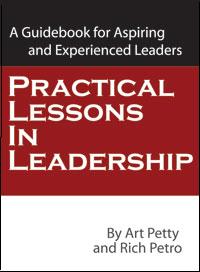 Much of the writing about leadership leaves out two of the most critical topics: power and politics. That’s a problem, because the political environment defines the playing field and those with the power dominate the organization’s agenda. Ignoring these facts of organizational life is a formula for futility.
Much of the writing about leadership leaves out two of the most critical topics: power and politics. That’s a problem, because the political environment defines the playing field and those with the power dominate the organization’s agenda. Ignoring these facts of organizational life is a formula for futility.
I’ve encountered more than a few great professionals who were uncertain over why they had plateaued in their climb up the corporate ladder. Upon closer review, they discovered that either ignoring or being ignorant of the political environment in their organizations was part of the problem.
Just to make certain you’re thinking through these issues, here’s a checklist of questions to ask and answer about your own workplace. The best way to answer these questions is to become a careful observer of “how things happen” in your workplace.
A Checklist to Help You Assess Politics and Power in Your Workplace:
Observe
1. How did the people you perceive as the most powerful get into their current roles? Seriously, what is it they did to arrive at their current lofty levels? Did it emerge from being problem solvers? Did they take and succeed with big risks? Were the rewarded for loyalty or longevity?
2. Who sets the agenda? Typically you’ll have to look below the C-level to find the individual(s) responsible for deciding what gets done and in what order. This individual parses top management goals and objectives and brings them to life. This individual is a power broker. Along with deciding what gets done, they often decide who is involved.
3. How are decisions made? Contrary to popular belief, most decisions take place somewhere below the senior management level. Study the processes of the informal decision-making culture in your firm. Who has a voice? Who has a vote? Who’s consulted? What are the criteria for moving forward on issues? Who can block issues?
4. Who’s working on the most strategic initiatives? Study the make-up and leadership of teams responsible for executing on key projects. How do people become attached to these initiatives?
 5. Who’s rising and who’s falling? Who’s gaining responsibility and who’s losing it? Power is typically a zero-sum game in an organization. For someone to ascend, someone else has to fall…or leave. Harsh, but most often true. Play close attention to the behaviors being rewarded and there are always lessons to be gained from those being edged or pushed out.
5. Who’s rising and who’s falling? Who’s gaining responsibility and who’s losing it? Power is typically a zero-sum game in an organization. For someone to ascend, someone else has to fall…or leave. Harsh, but most often true. Play close attention to the behaviors being rewarded and there are always lessons to be gained from those being edged or pushed out.
6. Who has the ear of top management? I particularly like the idea of observing who makes up the CEO’s “kitchen cabinet” …that informal group of advisors he/she draws upon when faced with critical issues. Surprisingly, this group often comes from the ranks below the CEO’s senior management team.
7. Who does everyone want to work for? Ambitious professionals strive to attach themselves to people they perceive can help them advance in their careers. In many organizations, there’s a senior manager who has developed a reputation as a career-maker. This individual is leading the big initiatives and the closer you are to him/her, the more likely it is that you will be selected for one of these high visibility programs.
8. How toxic is your environment? Gauging organizational toxicity is an imperfect science. I advise people to look at the strength (or absence) of the organization’s values in key decisions. Look at how people are treated. Watch top management closely to see how they behave in their roles. Does their do match their tell? This is one area in particular, where careful observation of the behaviors and approaches of those in charge and those striving to be in charge over a period of time will generate an increasingly accurate reading.
9. How powerful is your boss? In gauging your own power situation, it’s good to look at your boss and understand how she fits in the bigger picture. Is your boss involved in the big issues or part of the CEO’s “kitchen cabinet?” Is she active in both supporting and drawing upon resources and initiatives from other groups? Is she a rising star or a manager who has topped out at her current level?
10. When “It” hits the fan, who comes to the rescue? Is there a go-to person or team that is called upon for tough situations?
The Bottom-Line for Now:
Anywhere people gather, a political environment emerges with some individuals slightly more equal than others when it comes to making choices and gathering and dispensing resources. Instead of ignoring or assuming you are above the fray of these topics, work to strengthen your Political I.Q. by carefully observing how things happen in your workplace. Of course, the difficult issue is to move from observer to participant in a manner where you are engaged in a manner that doesn’t challenge you to compromise your ethics and values. That’s another topic for another day. For now, start paying attention! What you learn might just make your life in your organization a bit more rewarding.
—
Art Petty serves senior executives and management teams as a performance coach and strategy facilitator. Art is a popular keynote speaker focusing on helping professionals and organizations learn to survive and thrive in an era of change. Additionally, Art’s books are widely used in leadership development programs. To learn more or discuss a challenge, contact Art.
- Invite Leadership Caffeine to Your Next Meeting! Invite Art to speak.
- Subscribe to the Leadership Caffeine Newsletter with subscriber only content. Register here


- New to leading or responsible for first time leaders on your team? Subscribe to Art’s New Leader’s e-News.
